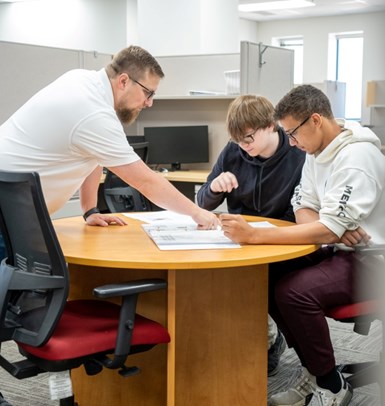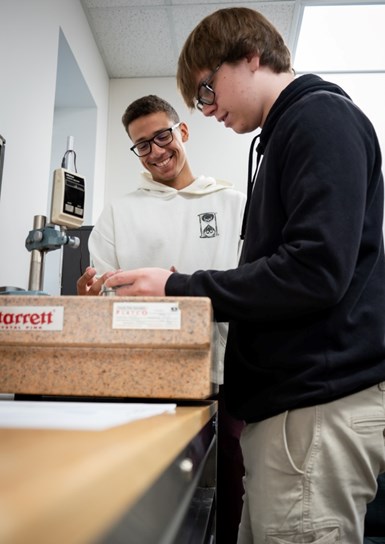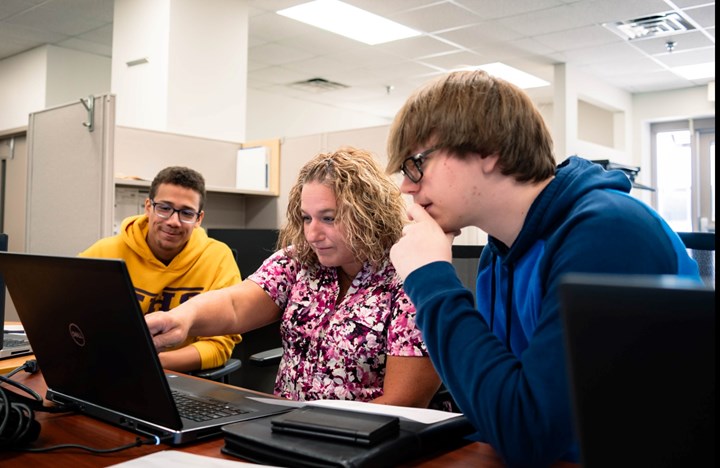
Anova Innovations Tooling Engineer Dan Saunders (left) discusses a blueprint with apprentices Nolan Benedict (center) and Alex McClinton (right). Photo Credit, all images: Luke Manendo.
Growing up in a family-owned tool shop where problem-solving was the rule of the day sparked one young man’s fascination with plastic injection moldmaking. From those early days, Jeff Mertz was on a mission to help grow the company and promote the industry in a unique way.
That shop was Custom Tool & Design (CTD), started by Jeff's father, Tom Mertz — a toolmaker by trade but an innovator and problem-solver by reputation. As the years went on, CTD’s work shifted and the team tackled many new challenges. Then in 2003, Tom retired and Jeff became sole owner. While building the business, he experienced intense cost pressures, forcing him to reinvent the company and do things differently.
He believed the future of moldmaking was in design and engineering, so he sought out a new generation of design engineers with innovative ideas and problem-solving skills to push designs to the next level. As a result, the company started designing molds around cooling efficiency, which translates into a reduction in cycle times, dimensional stability and increased parts per hour. In addition, they built engineering models around guaranteed cycle times.
“We put more and more inserts into the stack-up to get the cooling closer to the molding. We even welded parts together to increase cooling further, ultimately leading us to 3D-printed tooling, which I believed was a game-changer for the industry,” Mertz says.
Then in 2018, Mertz began searching for a partner who shared similar goals, and in January 2020 he sold the company to Tessy Plastics. Two months later, the world shut down, giving Mertz a chance to think about his next steps. The result was a new company focused on designing highly engineered tooling systems with tight tolerances and fast cycle times using 3D printing — Anova Innovations.
“We engineer the strategic use of 3D-printed metal inserts to enhance mold productivity and improve part quality for the medical, packaging and pharmaceutical industries, specializing in mold design and inspection services,” Mertz says.
However, this mission needed the right people in place. As he started to put the team together, Mertz realized it was difficult to find skilled workers, especially design engineers. After many discussions around this topic, something kept coming up: untapped resources. In other words, groups of people who might not investigate this field on their own.
One group that jumped out at Mertz was high school students in disadvantaged school districts. So, he dug into the surrounding school districts’ graduation and college entrance rates and focused on the high school with the lowest percentage of graduated and college-bound students.
In February 2021, he met with the head of the school co-op and one of the engineering teachers to formulate a plan. The vision was to provide a program that helps students in a disadvantaged school district start a technological career out of high school focused on mold design. To start, the co-op’s high school engineering teacher provided the four best students in her SolidWorks class (see “It Takes a Village” sidebar below).
The process is a five-phased approach (interview, paid internship, paid co-op, paid apprenticeship, journeyman), but it all begins with the interviewing process by a hiring team — the owner, three or four engineers and the human resources manager.

Apprentices Alex McClinton (left) and Nolan Benedict (right) take measurements of a part at Anova Innovations.
First, Mertz interviews for a cultural fit, as culture is the company’s foundation. Anova Innovations even officially documented the culture description to help select appropriate candidates:
- Relentless, continuous improvement internally and externally.
- Meeting company goals while maintaining positive partnerships with customers, coworkers and suppliers.
- Showing appreciation to everyone in the process.
- Innovative technology.
- Satisfaction in work.
- Open, honest communication.
- Data-driven decision-making.
- Proactive thinking: Begin with the end in mind.
- Working as a team while pushing self-reliance.
- Ability to mentor and teach.
- Enjoy being a student of the more experienced.
It's about how each person is going to integrate into the team. According to Mertz, the most critical personality characteristic is what he calls teacher/student. “You have to want to teach to work here and you have to want to be a student when you work here. Without those two things, you will hate working here. So we are all about teaching and learning from each other,” Mertz says.
Whether it is used for the selection of new employees or the development of already hired ones, this tool provides vital information that facilitates personal decision-making and supports the effective management of one’s career.
Next, Anova conducts NTMA’s four-phase written and psychological testing — mechanical and spatial relations, mechanical reasoning, applied mathematics and theoretical reasoning — from which they develop baseline scores everyone must meet to succeed. Then they move into psychological testing to determine if there are any issues they can’t manage in-house.
The personality test is called the NEO-PI-3, which according to Counseling and Assessment Services (Erie, Pennsylvania), uses a Five-Factor Model — conscientiousness, neuroticism, extraversion, agreeableness and openness to a new experience — to assess the essential traits which can determine an individual’s behaviors and reactions at work and in everyday life. Whether it is used for the selection of new employees or the development of already hired ones, this tool provides vital information that facilitates personal decision-making and supports the effective management of one’s career.

Mimi McCorkle (center), who teaches engineering at Erie High School in Erie, Pennsylvania, discusses a project with Alex McClinton (left) and Nolan Benedict (right).
Dimensioning to Design
If it’s a fit, the paid internship is next. Then, the summer before senior year, the company concentrates training on engineering. The engineering manager designs the mold, the interns do all the dimensioning and detailing and the tooling engineer reviews moldmaking fundamentals.
The program does this in three ways:
- A senior moldmaker teaches what a mold is and how it works — strippers, core pins, etc.
- A plastics engineer teaches how a mold runs, reviews a molding machine and students watch a machine run at the AIM Institute (two-day concentrated class).
- An engineering manager uses a TV monitor in a big conference room to teach the interns how to design a mold while at their monitors. First, he conceptualizes the mold and the students dimension the components of the mold. Then, they work on multiple mold designs to improve cooling and learn about stress analysis and molding requirements.
“The key to engaging young people is talking about the future of moldmaking, including its exciting new technology and working on real projects,” Mertz notes. “It drives enthusiasm. It’s going to take a little bit longer, but you need to plan around that.”
Next is the paid co-op, which is two to three months during senior year. At this point, the program moves away from molding and nondesign-related tasks and concentrates on pure dimensioning over two or three months (about 15 hours a week).
Interns work on a live mold project with the engineering manager, detailing in Creo. Then, at the end of the summer, they have a full set of mold drawings to bring to school for show and tell.
Helping Them Stay
After the four-year apprenticeship, the apprentice rolls into a journeyman, which comes with additional pay raises and bonuses and benchmarks. Updated designs, preliminary designs, work on the production floor, classroom instruction and basic math are key benchmarks to measure progress.
Anova is investing a lot of time and money into next generation. Their experience is that apprentices often leave in the first or second year, so if you can keep them around for the additional four years, they will most likely stick around. Interns get a pay increase for finishing the apprenticeship and then again when they become a journeyman, but Anova created a financial handcuff for additional insurance.
Over the four years of their apprenticeship, students put $3 an hour into a fund for every hour they’re working across those four years. Then, once they finish their apprenticeship, they can pull that out every hour for the additional four years. This is all to help apprentices understand how much this costs and how valuable it is.
Interns get a pay increase for finishing the apprenticeship and then again when they become a journeyman, but Anova created a financial handcuff for additional insurance.
Mertz recommends a paid 8,000-hour apprenticeship (Anova’s is registered with the state of Pennsylvania where they are located) with incremental pay increases as students work through the apprenticeship.
“We were given four candidates who went through the interview steps and in June 2021, we hired two interns. Our tooling engineer stopped in their first training class and said, ‘You need to understand something. The training you are getting is unheard of. Anova is taking an enormous leap of faith to provide you with tools that will change your life.’ That statement hit me hard,” Mertz says.
But something even better happened. Mertz received a phone call from the engineering teacher telling him that the whole school was buzzing about the internship they provided. The interns not only showed off their newfound skills, they told anyone who would listen about how awesome the manufacturing world is.
“It was then that I realized maybe we can start getting skilled labor back!” Mertz says. “The company’s been in business for a year and we’ve done $1.5 million in sales. It is a definite working model. We are creating a buzz about moldmaking and 3D printing in school and society!”
Related Content
Exploring ISO 9000 - Part 16 Control of Quality Records
A Series of International Standards for Quality Management and Quality Assurance. We begin 2022 with a review of Clause 4.16 Control of Quality Records.
Read MoreMaking Quick and Easy Kaizen Work for Your Shop
Within each person is unlimited creative potential to improve shop operations.
Read MoreThe Role of Social Media in Manufacturing
Charles Daniels CFO of Wepco Plastics shares insights on the role of social media in manufacturing, how to improve the “business” side of a small mold shop and continually developing culture.
Read MoreMMT Chats: Acquisition Trends and Lessons for Mold Builders
Jim Berklas is a former full-time M&A lawyer for several of the largest private equity firms in the country and has 25 years of M&A experience and 200 closed transaction. Today, he is founder and M&A Leader with Augmented Industry Services. He joins me for this MMT Chat on mergers and acquisitions trends and strategies within in the mold manufacturing industry. This episode is brought to you by ISCAR with New Ideas for Machining Intelligently.
Read MoreRead Next
MMT Chats: Promoting Plastics One Student at a Time
MoldMaking Technology Editorial Director Christina Fuges chats with Eve Vitale a chief executive with the Society of Plastics Engineers (SPE) Foundation about her passion for plastics via Plastivan—an educational tool whose mission is to change the perception of plastics one classroom at a time. This episode is brought to you by ISCAR with New Ideas for Machining Intelligently.
Read MoreMMT Chats: A Man on a Mission to Tool Up Fellow Mold Builders
MoldMaking Technology Editorial Director Christina Fuges is honored to sit down with Charlie Harris—a man who has made it his mission to find and donate cutting tools with the mold building community. Charlie is one of many mold builders who are giving back to the community by donating products, technology and skills to move moldmaking forward. This episode is brought to you by ISCAR with New Ideas for Machining Intelligently.
Read MoreTaking a Holistic Approach to Training Is Filling a Local Skills Gap
Success coaches through JEVS Human Services’ Tri-State Apprenticeship Program (JTAP) provide guidance and a different way of learning for the whole person for small- to mid-sized manufacturers.
Read More










_300x250 4.png;maxWidth=300;quality=90)












.jpg;maxWidth=300;quality=90)







